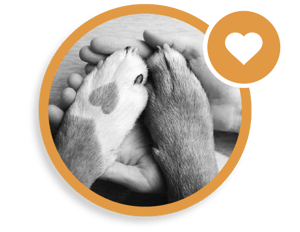Common Pet Health Conditions in Canada

With the cost of owning a pet in Canada constantly rising (and especially with current levels of inflation), it’s not surprising that pet owners are always on the lookout for ways to lower the risks of pet ownership.
Dogs and cats and in Canada experience some conditions more than others, in part because of the different climate and landscape. Only approx. 3% of pet owners in Canada have pet insurance and this leaves many pet owners open to financial risk - and their pets can be impacted by those risks too.
Understanding what things to look out for in your Canadian cat or dog can help - whether you have pet insurance or not.
Expected Pet Costs
Between medical care, preventative treatments, food, supplies, toys, and more, pets can end up costing a lot more than you might realize. Last year, the expected cost for owning a dog in Canada came out to about $3,724.00 each year after costing anywhere from $4,589 and $4,666 in the first year of puppy ownership. For cats, the annual projected cost is around $2,542 with the first year costing between $3,091 and $3,231. These estimates include food costs, spay/neuter, microchipping, preventative medicine – and more – but one of the most important parts is the annual pet insurance cost.
Pet insurance can be a lifesaver (literally) if your pet becomes suddenly ill or seriously injured somehow. Depending on where you live, the skills of the veterinary staff, and the needs of your pet, the cost of medical care in such scenarios can range from moderate to very sizeable. This is why pet insurance is a smart move for any pet owner, the insurance will help cover costs in the event something unexpected happens to your furry friend.
In the event your pet was to be hit by a car and had a broken leg, the average cost can range from several hundred dollars up to $3,500. For a severe break involving multiple bones, the costs of hospitalization, radiographs, anaesthesia, surgery, pain medication, and follow-up visits can quickly grow even higher. Without pet insurance to help cover costs, this type of injury, or an illness requiring a hospital stay, can put pet owners into significant financial pressure, or even force them into debt.
Here we look at some of the common conditions that pets experience in some of Canada, broken out by province. While some conditions are fairly constant across all of them - there are some surprises too. Being prepared with pet insurance can help preserve household budgets and your pet's health and wellbeing.
Statistics for Some Canadian Provinces
** Pet population figures extracted from Abacus Data.
| Provinces | Human Population | Pet Population | Average Temperatures in Hottest Month | Average Temperatures in Coldest Month | Common Pet Conditions |
| Alberta | 4.5 million | 2.25 million |
High of 23°C Low of 7°C |
High of -1°C Low of -19°C |
|
| British Columbia | 5.3 million | 2.58 million |
High of 29°C Low of 13°C |
High of 6°C Low of 1°C |
|
| Manitoba | 1.4 million | 0.66 million |
High of 26°C Low of 16°C |
High of -10°C Low of -18°C |
|
| Ontario | 15 million | 9.4 million |
High of 28°C Low of 7°C |
High of -1°C Low of -26°C |
|
| Saskatchewan | 1.2 million | 0.56 million |
High of 25°C Low of 12°C |
High of -10°C Low of -19°C |
|
So sorry Quebec, Nova Scotia, New Brunswick, Newfoundland & Labrador & Prince Edward Island. We love you but couldn’t find enough data to include useful stats here. We’ll keep working on it.
Common Health Conditions
Vomiting
Vomiting, or the expulsion of food, water, acid and saliva from the stomach, is a common problem for our furry friends. You may notice your pet drooling, licking their lips, swallowing frequently, and becoming increasingly restless immediately before they throw up.
More often than not, our pets will vomit after eating something that didn’t agree with them, but it can also be a sign of something more serious. If your pet vomits several times in one day, at least once daily for several days, and or begins acting unusually, your pet should see their veterinarian asap.
Vomiting and diarrhea
The combination of vomiting and diarrhea is serious, not only as the potential result of an illness or disease affecting your pet but also due to the high risk of severe dehydration. Vomiting and diarrhea in the same time frame are indicators that your pet’s digestive system is very upset, inflamed, and/or damaged.
A brief bout of vomiting and diarrhea can easily be explained by an internal infection, bad food, or dietary indiscretion. Vomiting and diarrhea which goes on for 12 hours or more should be discussed with your pet’s veterinarian, especially if your pet seems lethargic, fatigued, or otherwise sickly.
Otitis
Otitis, more commonly known in pets as ear infections, can range from uncomfortable and gross to extreme pain and hearing loss for our pets. Although infections can develop in the inner and middle ear, the outer ear infections are what most pets suffer from, likely due to the close proximity to the excess hair, earwax, dirt, moisture, and debris of the outside world.
Treatment for your pet’s ear infection begins with a thorough examination from their veterinarian. Any foreign material, fur, earwax, and infection will be flushed from the ear, and your vet may choose to prescribe an antibiotic.
Allergies
Just like people, our furry friends can suffer from allergies triggered by their diet and immediate environment. Though there can be many symptoms associated with pet allergies, some of the most common should sound familiar: sneezing, watering eyes, general itchiness, hives, and irritated skin.
If your pet seems to be having allergic reactions, you’ll need to work closely with their veterinarian to understand your pet’s allergic triggers and how to avoid them. Dietary allergies may require a trial and error of new diets, where environmental allergies are best treated by minimizing contact with the dust, dander, pollen, grass, or other allergens that bother your pet.
A mass
Noticing a mass somewhere on your pet’s body can feel scary and overwhelming, but you should know that not all masses are reasons for serious concern or immediate action. Veterinarians often use a 1-2-3 rule to determine if a mass needs prompt evaluation; this may include any masses which are present for more than one month, have grown to twice their original size, or is larger than three cm in diameter.
Some masses, such as abscesses are easily treated with minor surgery, clearing out any infection, dead tissue, or mass tissue from the area, and keeping the wound clean while it heals. Other types of masses, like cysts and tumors, often need to be removed immediately, and potentially biopsied for your pet’s best treatment plan.
Ingestion of foreign material
Our pets have a bad habit of eating things they shouldn’t, and although it doesn’t always end badly, it can sometimes be catastrophic. The largest concerns regarding ingestion of foreign material are the risks of an obstruction which could compromise or cut off blood supplies, or that the intestinal tract could be severely damaged.
If your pet has ingested foreign material, you may notice vomiting, diarrhea, abdominal tenderness, decreased appetite, straining to defecate, and lethargy. Although foreign materials can sometimes be passed on their own, your veterinarian may want to monitor your dog for any complications. Additionally, ingestion of foreign material can sometimes cause an obstruction, which requires immediate surgery to save the animal.
Lameness or limping
The presence of a limp or lameness in your pet’s gait can be caused by countless injuries ranging from minor to severe. Mild injuries could include an extra-long nail, thorn in their foot, or cut on the paw pad, while more serious issues may include a sprain, dislocation, or broken bone.
If your pet’s limping is short-lived or improves over the course of a few days, your pet will likely recover with no issues. Your pet should see their veterinarian if they are limping consistently, or experience other symptoms such as dragging their limb, excessive swelling, extreme pain, or signs of other illness.
If you still have question on pet insurance in Canada then please check through other articles in our blog which includes lots of hints and tips - like how to choose the right pet insurance and a guide to some common pet insurance terms.
It is essential that you seek advice from your veterinarian for all medical questions or concerns with your pet. The quality of your relationship with your veterinarian will determine many of your pet's health and happiness outcomes.
Posted on June 29, 2022 | Categories: Cats Pet Insurance DOGS Kitten Puppy
Share


